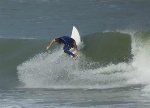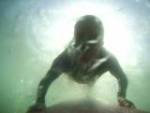Roh Dahomey t'es dur, je pense pas que c'était pour toi et c'était une vanne sur le débat en général.
C'est marrant, je pensais que tu trouvais la HK trop courte et en même temps tu as l'air de dire que c'est un paquebot.
C'est à cause du volume?
Est ce que tu as pu essayer ce genre de shape? Parce que visiblement c'est simplement différent de ce qui a pu se faire avant.
Désolé si tu as déjà dit tout ça, mais ça part tellement dans tout les sens...
@Macwill: en snow aussi si tu as un programme Pow tu prends pas une planche de park. Les riders performants qui font de tout ont un quiver. Les spécialisés ont un quiver spécialisé en fonction.
Mais j'ai qu'une planche de snow. Elle est un peu moyenne dans tous les domaines mais ça passe tranquille.
Là le programme/le type de vague je l'ai annoncé, mon niveau et mon gabarit aussi. Une fois que ça c'est posé, et qu'on sait que je vais pas charger à plus de 2m, normalement il pourrait y avoir moyen d'avoir un faisceau de choix?
En fait personne m'a proposé un modèle à part la HK je crois.
Et comme elle est atypique, que les cotes sont quand même bien différentes des planchons classiques, ça a l'air de créer des clivages.
[Avis] Conseils pour changer de planche
Re: [Avis] Conseils pour changer de planche
Sans compter les gouts de chacun....
Regarde Dahomey qui aime les petites planches, et sais parfaitement s'en servir, Eric25 les paquebots, moi les LB perfo (surtout dans les shorebreaks, comme quoi), Pelou qui surfe souvent en 7'2 Surftech et HK..
Et tout ça, essentiellement pour une affaire de gouts et de convenance personnelle....
Regarde Dahomey qui aime les petites planches, et sais parfaitement s'en servir, Eric25 les paquebots, moi les LB perfo (surtout dans les shorebreaks, comme quoi), Pelou qui surfe souvent en 7'2 Surftech et HK..
Et tout ça, essentiellement pour une affaire de gouts et de convenance personnelle....
RNV Family Guesthouse / BatuKaras - Jawa Barat - Indonesia
https://www.rnv-family-guesthouse-batukaras.com/
https://www.rnv-family-guesthouse-batukaras.com/
-

nicodisco - Messages: 6689
- Enregistré le: Mar Nov 27, 2012 13:18
- Nombre de sessions: 365
Re: [Avis] Conseils pour changer de planche
Non ce n'est pas sur la hk que je fais référence dans le paquebot mais au début c'était partit sur une 6'6 avec minimum 19'1/2 et plus de large c'est la que j'ai réagi. :;-):
La hk je ne la connais pas sinon de vue mais ca reste une planche atypique pour moi et moins sur du coup que un sb classique et donc je m'abstiens même si je trouve que en volume ca fait beaucoup. Si tu prends les calculateurs des sites pour trouver ta board il ne font que adapter le volume connaissant l'outline en fonction de ton poids et niveau.Moi par exemple mon volume de board et 24/25l pour 74kg selon le niveau forcément tu montes le volume.
Si je mets un niveau intermédiaire ca me mets 26l et debutant 28@ 29l.
Je pense que ton choix de base était le bon ceci étant
Si j'avais conseillé une galette alors oui j'aurai dit une 5'11x18x2'1/4.....
La hk je ne la connais pas sinon de vue mais ca reste une planche atypique pour moi et moins sur du coup que un sb classique et donc je m'abstiens même si je trouve que en volume ca fait beaucoup. Si tu prends les calculateurs des sites pour trouver ta board il ne font que adapter le volume connaissant l'outline en fonction de ton poids et niveau.Moi par exemple mon volume de board et 24/25l pour 74kg selon le niveau forcément tu montes le volume.
Si je mets un niveau intermédiaire ca me mets 26l et debutant 28@ 29l.
Je pense que ton choix de base était le bon ceci étant

Si j'avais conseillé une galette alors oui j'aurai dit une 5'11x18x2'1/4.....
-

dahomey - Messages: 9914
- Enregistré le: Sam Mai 01, 2010 13:11
- Localisation: Bordeaux
Re: [Avis] Conseils pour changer de planche
pour ta référence au snow justement tu ne pars pas dans une half pipe avec un alpin de 178cm ou faire un slalom avec un freestyle bien large 

-

dahomey - Messages: 9914
- Enregistré le: Sam Mai 01, 2010 13:11
- Localisation: Bordeaux
Re: [Avis] Conseils pour changer de planche
Extrait de SURFER (surfermag.com , rubrique design)
Voila voila....
Surfermag a écrit:OPT FOR A ROUNDED TAIL: A rounded tail will help draw out the shape of the board, keeping more of the rail in the water. At J-Bay, a point known for its blisteringly fast sections, a rounded tail is a necessity. “When Supers starts firing at 4- to 8-foot, we’ve found that rounded pins are the go-to tail,” says Jon Pyzel, shaper for John Florence, among others. “You’ll need that drive they create to keep pace ***spam*** the wave. Rounded pins give you a bit more flow while also increasing your ability to connect your turns. Having that little bit of extra rail makes a big difference when you’re racing past a section.”
STICK ***spam*** A THRUSTER: While the last few years have seen quad setups grow in popularity, Santa Barbara shaper Jason Feist still believes that standard thrusters are superior for pointbreaks. “I’d say that 80 to 90 percent of my customers are still sticking ***spam*** thruster setups when they get boards for Rincon. I think that’s a solid choice. For that one-in-a-million-wave where it’s hollow from the takeoff point all the way through the rest of the wave, you can ride a quad to get that extra speed you need, but for the vast majority of points, a thruster setup is what you want. It’ll offer you a little more connection to the wave and will help you link your turns together a little easier, which is exactly what you want.”
THE DIFFERENCE OF A FEW INCHES: “I see a lot of guys on shorter boards not making the sections and doing small turns that are lost on the long walls of J-Bay,” says Andrew Carter, a South African shaper who’s shaped more than his fair share of boards for Jeffreys Bay. “When it comes to surfing a solid pointbreak that’s really standing up, you can go a little bit bigger than your standard shortboard,” agrees Feist. “An inch or so should do it. It’ll give you a little more rail that you can really use to your benefit.”
NARROW YOUR OUTLINE: “You don’t want to do anything too drastic,” says Pyzel, “but if the wave is at all powerful and not burgering out, you can go a little more narrow. This’ll make it easier for you to transition from one rail to the other, give you a quicker reaction time, and help you link your turns together faster.”
ADD SOME VOLUME: Typically when you’re surfing a point, you’ll be doing a lot more paddling than you would at your standard beachbreak. You’ll likely appreciate a little extra foam after riding a leg-burner and staring down 150-yard paddle. “We like to go about 1/8 or 1/4 inch thicker than your standard shortboard,” says Thys Strydom of J-Bay’s Rebel Surfboards. “When the waves are good and the wind is really blowing, that extra bit of thickness really helps ***spam*** paddling into a set and back out to the lineup.”
BUY LOCAL: “If you can, I’d definitely recommend ordering a board from a shaper that knows the point you’re looking to surf,” says Pyzel. “Take advantage of their local knowledge. They’ll know the wave—and what boards will work best—better than anyone.”
Voila voila....
RNV Family Guesthouse / BatuKaras - Jawa Barat - Indonesia
https://www.rnv-family-guesthouse-batukaras.com/
https://www.rnv-family-guesthouse-batukaras.com/
-

nicodisco - Messages: 6689
- Enregistré le: Mar Nov 27, 2012 13:18
- Nombre de sessions: 365
Re: [Avis] Conseils pour changer de planche
Ok!
Meh...de toute façon le surfshop ou j'avais trouvé la HK, les seules cotes qu'y ont pas c'est 5"8...
Normal.
Bon donc je vais rester dans du classique. Chez JS ya toujours la FMN en pin ou en squash.
6.3 * 19 * 2 1/2
Vous en pensez quoi?
Meh...de toute façon le surfshop ou j'avais trouvé la HK, les seules cotes qu'y ont pas c'est 5"8...
Normal.
Bon donc je vais rester dans du classique. Chez JS ya toujours la FMN en pin ou en squash.
6.3 * 19 * 2 1/2
Vous en pensez quoi?
- Toolbox
- Messages: 54
- Enregistré le: Jeu Nov 07, 2013 23:44
Re: [Avis] Conseils pour changer de planche
Toolbox a écrit:
Bon donc je vais rester dans du classique. Chez JS ya toujours la FMN en pin ou en squash.
6.3 * 19 * 2 1/2
Vous en pensez quoi?
Mais il insiste en plus !

-

macwill - Messages: 664
- Enregistré le: Mar Aoû 27, 2013 12:12
Re: [Avis] Conseils pour changer de planche
macwill a écrit:Toolbox a écrit:
Bon donc je vais rester dans du classique. Chez JS ya toujours la FMN en pin ou en squash.
6.3 * 19 * 2 1/2
Vous en pensez quoi?
Mais il insiste en plus !

RNV Family Guesthouse / BatuKaras - Jawa Barat - Indonesia
https://www.rnv-family-guesthouse-batukaras.com/
https://www.rnv-family-guesthouse-batukaras.com/
-

nicodisco - Messages: 6689
- Enregistré le: Mar Nov 27, 2012 13:18
- Nombre de sessions: 365
Re: [Avis] Conseils pour changer de planche
Je pense que cette planche ( la FMN de JS) correspond bien au programme que tu recherche. Le volume est d'environ 29litres, la largeur raisonnable et le rocker pas trop plat. Bref, une planche assez passe partout et pas trop exigeante. La hk est certainement une tres bonne planche, a mon avis assez proche de la pod que je connais tres bien. Mais si tu souhaites surfer des vagues un peu creuses ( et pas forcement >1.5m), elle trouvent vite leurs limites en raison de leurs rails boxys et de leur rocker assez plat.
En tous cas, je te souhaite un très bon trip
Aloha
En tous cas, je te souhaite un très bon trip
Aloha
Modifié en dernier par grabtherail le Ven Mai 09, 2014 19:38, modifié 1 fois.
-

grabtherail - Messages: 83
- Enregistré le: Mer Juin 18, 2008 07:29
Re: Re : [Avis] Conseils pour changer de planche
nicodisco a écrit:Extrait de SURFER (surfermag.com , rubrique design)Surfermag a écrit:OPT FOR A ROUNDED TAIL: A rounded tail will help draw out the shape of the board, keeping more of the rail in the water. At J-Bay, a point known for its blisteringly fast sections, a rounded tail is a necessity. “When Supers starts firing at 4- to 8-foot, we’ve found that rounded pins are the go-to tail,” says Jon Pyzel, shaper for John Florence, among others. “You’ll need that drive they create to keep pace ***spam*** the wave. Rounded pins give you a bit more flow while also increasing your ability to connect your turns. Having that little bit of extra rail makes a big difference when you’re racing past a section.”
STICK ***spam*** A THRUSTER: While the last few years have seen quad setups grow in popularity, Santa Barbara shaper Jason Feist still believes that standard thrusters are superior for pointbreaks. “I’d say that 80 to 90 percent of my customers are still sticking ***spam*** thruster setups when they get boards for Rincon. I think that’s a solid choice. For that one-in-a-million-wave where it’s hollow from the takeoff point all the way through the rest of the wave, you can ride a quad to get that extra speed you need, but for the vast majority of points, a thruster setup is what you want. It’ll offer you a little more connection to the wave and will help you link your turns together a little easier, which is exactly what you want.”
THE DIFFERENCE OF A FEW INCHES: “I see a lot of guys on shorter boards not making the sections and doing small turns that are lost on the long walls of J-Bay,” says Andrew Carter, a South African shaper who’s shaped more than his fair share of boards for Jeffreys Bay. “When it comes to surfing a solid pointbreak that’s really standing up, you can go a little bit bigger than your standard shortboard,” agrees Feist. “An inch or so should do it. It’ll give you a little more rail that you can really use to your benefit.”
NARROW YOUR OUTLINE: “You don’t want to do anything too drastic,” says Pyzel, “but if the wave is at all powerful and not burgering out, you can go a little more narrow. This’ll make it easier for you to transition from one rail to the other, give you a quicker reaction time, and help you link your turns together faster.”
ADD SOME VOLUME: Typically when you’re surfing a point, you’ll be doing a lot more paddling than you would at your standard beachbreak. You’ll likely appreciate a little extra foam after riding a leg-burner and staring down 150-yard paddle. “We like to go about 1/8 or 1/4 inch thicker than your standard shortboard,” says Thys Strydom of J-Bay’s Rebel Surfboards. “When the waves are good and the wind is really blowing, that extra bit of thickness really helps ***spam*** paddling into a set and back out to the lineup.”
BUY LOCAL: “If you can, I’d definitely recommend ordering a board from a shaper that knows the point you’re looking to surf,” says Pyzel. “Take advantage of their local knowledge. They’ll know the wave—and what boards will work best—better than anyone.”
Voila voila....
Voila voila .....C'est intéressant mais du coup tu lui conseils quoi en te basant sur ça?
Je pense qu'avec des côtes comme ca tu minimises le risque justement et c'est plutôt bien car en plus ca te servira partout.
-

dahomey - Messages: 9914
- Enregistré le: Sam Mai 01, 2010 13:11
- Localisation: Bordeaux
Re: [Avis] Conseils pour changer de planche
6'4 * 19'5 * 2 1/2 ou 2 3/4 pour avoir un peu de volume, un round pin pas trop sevère, et go....
RNV Family Guesthouse / BatuKaras - Jawa Barat - Indonesia
https://www.rnv-family-guesthouse-batukaras.com/
https://www.rnv-family-guesthouse-batukaras.com/
-

nicodisco - Messages: 6689
- Enregistré le: Mar Nov 27, 2012 13:18
- Nombre de sessions: 365
Re: [Avis] Conseils pour changer de planche
Bon ben voilà, je vais pas me (et vous) prendre la tête 15ans avec ça.
Ça fera un bon all rounder.
Je vais la prendre en pintail et puis ça va le faire.
Merci à tous!
Ça fera un bon all rounder.
Je vais la prendre en pintail et puis ça va le faire.
Merci à tous!
- Toolbox
- Messages: 54
- Enregistré le: Jeu Nov 07, 2013 23:44
Re: [Avis] Conseils pour changer de planche
2 3/4 c'est de trop, ça va pas la tête, on parle d'un short pour pour les Maldives pas un mullet pour les boulasses ...
-

Tibok - Site Admin
- Messages: 6557
- Enregistré le: Lun Déc 03, 2007 21:52
- Localisation: Pessac
- Nombre de sessions: 7
Re: [Avis] Conseils pour changer de planche
Toolboox, je crois que tu as largement les réponses quiet permettront de faire ton choix !
-

Tibok - Site Admin
- Messages: 6557
- Enregistré le: Lun Déc 03, 2007 21:52
- Localisation: Pessac
- Nombre de sessions: 7
Re: [Avis] Conseils pour changer de planche
Et maintenant, rendez-vous sur le topic pour choisir ses dérives 

- Nicop
- Messages: 66
- Enregistré le: Mer Juil 20, 2011 14:40
Qui est en ligne
Utilisateurs parcourant ce forum : Aucun utilisateur enregistré et 5 invités


